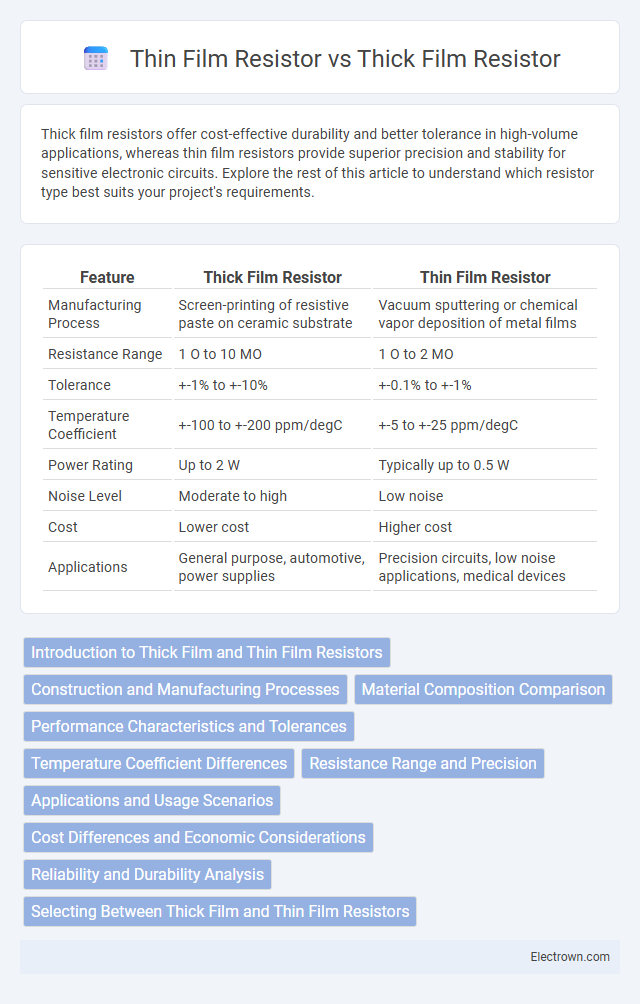Thick film resistors offer cost-effective durability and better tolerance in high-volume applications, whereas thin film resistors provide superior precision and stability for sensitive electronic circuits. Explore the rest of this article to understand which resistor type best suits your project's requirements.
Table of Comparison
| Feature | Thick Film Resistor | Thin Film Resistor |
|---|---|---|
| Manufacturing Process | Screen-printing of resistive paste on ceramic substrate | Vacuum sputtering or chemical vapor deposition of metal films |
| Resistance Range | 1 O to 10 MO | 1 O to 2 MO |
| Tolerance | +-1% to +-10% | +-0.1% to +-1% |
| Temperature Coefficient | +-100 to +-200 ppm/degC | +-5 to +-25 ppm/degC |
| Power Rating | Up to 2 W | Typically up to 0.5 W |
| Noise Level | Moderate to high | Low noise |
| Cost | Lower cost | Higher cost |
| Applications | General purpose, automotive, power supplies | Precision circuits, low noise applications, medical devices |
Introduction to Thick Film and Thin Film Resistors
Thick film resistors are constructed by screen-printing a resistive paste onto a ceramic substrate, offering cost-effective solutions with high power ratings and excellent stability in harsh environments. Thin film resistors are created by sputtering a thin layer of resistive material onto an insulating substrate, providing superior precision, low noise, and tight tolerance for high-frequency and sensitive electronic applications. Both resistor types serve distinct roles in electronic circuits based on performance requirements, manufacturing processes, and application environments.
Construction and Manufacturing Processes
Thick film resistors are constructed by screen-printing a paste of conductive materials onto a ceramic substrate and then firing it at high temperatures to solidify the film, resulting in a durable and cost-effective component. Thin film resistors are manufactured using vacuum deposition techniques, such as sputtering or evaporation, to deposit a resistive metal layer on an insulating substrate, allowing for precise control over thickness and resistance values. Your choice between thick film and thin film resistors depends on the required tolerance, stability, and manufacturing complexity for your application.
Material Composition Comparison
Thick film resistors are typically made from a mixture of ceramic and glass materials combined with metallic oxides such as ruthenium oxide, allowing them to be screen-printed onto substrates. Thin film resistors use a pure metal or metal alloy film, often nickel-chromium or tantalum nitride, deposited through sputtering or evaporation onto an insulating substrate, resulting in higher precision and stability. The material composition differences directly influence performance characteristics like tolerance, temperature coefficient, and noise levels in electronic applications.
Performance Characteristics and Tolerances
Thick film resistors typically exhibit higher noise levels and less precision, with tolerances ranging from +-1% to +-5%, making them suitable for general-purpose applications. Thin film resistors provide superior performance with low noise, high stability, and tighter tolerances as precise as +-0.1%, ideal for high-frequency and precision circuits. Thermal stability and resistance to environmental factors are generally better in thin film resistors due to their uniform, sputtered metal oxide layers compared to the screen-printed layers of thick film types.
Temperature Coefficient Differences
Thick film resistors typically exhibit higher temperature coefficients, often ranging from +100 to +300 ppm/degC, which means their resistance changes more noticeably with temperature fluctuations. Thin film resistors maintain much lower temperature coefficients, generally between +-5 and +-25 ppm/degC, offering superior stability and precision in sensitive applications. Understanding these temperature coefficient differences helps you select the right resistor type for environments where thermal stability and accuracy are crucial.
Resistance Range and Precision
Thick film resistors typically offer a resistance range from a few ohms up to several megaohms with precision around +-1% to +-5%, suitable for general-purpose applications. Thin film resistors provide a wider resistance range, from less than one ohm to over 1 megaohm, with higher precision levels as tight as +-0.1% or better, making them ideal for high-accuracy circuits. The choice between thick film and thin film resistors depends largely on the required precision and resistance stability in specific electronic designs.
Applications and Usage Scenarios
Thick film resistors are commonly used in general-purpose electronic devices, automotive circuits, and industrial equipment due to their cost-effectiveness and durability under high power dissipation. Thin film resistors excel in precision applications such as medical instruments, aerospace electronics, and calibration equipment where tight tolerance, low noise, and stability over temperature are critical. Both types serve distinct roles in circuit design, with thick film resistors favored for robust, high-volume applications and thin film resistors chosen for high-performance, low-noise requirements.
Cost Differences and Economic Considerations
Thick film resistors are generally more cost-effective due to simpler manufacturing processes and lower material expenses, making them ideal for high-volume, low-cost applications. Thin film resistors offer superior precision and stability but incur higher production costs, which can impact budget constraints in large-scale projects. Economic considerations favor thick film technology for standard tolerance requirements, while thin film is chosen for applications demanding low noise and tight resistance tolerances despite higher costs.
Reliability and Durability Analysis
Thick film resistors exhibit lower reliability under high-temperature and high-stress conditions due to their porous ceramic substrate, which can lead to moisture absorption and subsequent resistance drift. Thin film resistors offer superior durability and stability, attributed to their dense metal film deposition on a glass or ceramic substrate, resulting in lower noise and enhanced tolerance to thermal cycling. Long-term reliability tests demonstrate thin film resistors maintain resistance values with +-1% variation over extended periods, outperforming thick film counterparts, which may experience variations exceeding +-5% under similar environmental stresses.
Selecting Between Thick Film and Thin Film Resistors
Selecting between thick film and thin film resistors depends on your application's precision and cost requirements. Thick film resistors offer cost-effective solutions with moderate accuracy and high power rating, making them ideal for general-purpose applications. Thin film resistors provide superior tolerance, stability, and low noise, suited for high-precision and sensitive electronic circuits.
Thick film vs Thin film resistor Infographic

 electrown.com
electrown.com